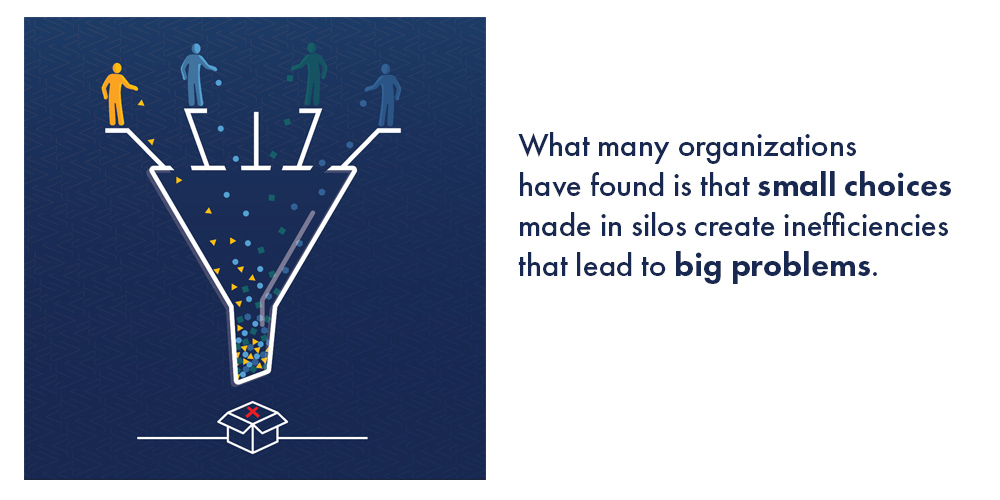Digital Solutions to Navigate Challenges and Drive Innovation

Key Takeaways
- Hybrid and remote working coupled with piecemeal solutions and security concerns have forced organizations to re-evaluate their digital environments.
- Start with business outcomes, take inventory of your technology, evaluate your data strategy, and align your business and technology strategies for long-term digital success.
- Look for partners who can help you see past your blind spots and help you create a roadmap for the future.
Organizations are focused on being more customer-centric, innovative, and sustainable. Yet their technology capabilities often prevent their success. After three years of post-pandemic emergency response, organizations are now faced with new challenges—a talent scarcity, domestic and global economic pressures, and the rate of change in technology. After a forced digital response, it’s time to prioritize and strategize for new opportunities.
What’s Driving the Need for Re-Evaluation?
- The immediate need for organizations to switch to remote and hybrid environments resulted in quick acquisitions of cloud collaboration software, ultimately resulting in unused features and services or duplicative applications.
- Many applications that organizations introduced during the pandemic, combined with the increased rise in remote workers and devices, have increased the risk of cybersecurity breaches.
- Piecemeal solutions have led to constraints on integration capabilities and the lack of a data strategy.

4 Steps Turn Your Digital Response into a Digital Future
1. Start with outcomes.
It’s important to start with outcomes. Defined business outcomes and a widespread understanding of what improvement looks like makes it easier to start the journey toward your digital future.
Organizations that rely on the IT department alone to spearhead technology initiatives do not get the results they want at the pace they desire. This is because the IT department doesn’t have a full view of the overall desired business outcomes. You can’t create lasting and meaningful change in a vacuum. Building a digital future is about transforming the way people work, and it takes a coordinated cross-team effort to turn that vision into reality.
Successful digital futures are the result of input from all areas of the organization. A diversified team of IT staff, business experts, and executive leadership—with support and buy-in from each department in your organization—will help ensure business outcomes are met.
2. Take inventory of your tech.
Research from Productiv found that the overall average software as a service (SaaS) portfolio across organizations of all sizes is 254. Yet less than half of these app licenses are actually being used on a regular basis. Additionally, the study found organizations often had five or more tools belonging in the same category.
Begin turning your digital response into a strategic plan for a digital future by taking a thorough inventory of your current software. Identify gaps and overlaps in your technology landscape by examining:
- What do I have?
- What is it capable of?
- What am I using it for?
Cutting waste is imperative if you’re looking to get the maximum value out of your investments. This doesn’t just apply to software licensing costs; Flexera reports that organizations waste more than 32% of their cloud storage on unnecessary applications. Evaluating the number and type of applications your organization utilizes and examining the rates of end-user adoption can eliminate waste and increase efficiency across your organization.
3. Evaluate your data strategy.
Next, evaluate the quality and accessibility of your data. At any moment in time, you should be able to easily access accurate, real-time data from across your organization. That data should be able to tell a story about where your organization has been, where it is, and where it’s going. As the role of the financial office has evolved, top-performing CFOs are defining a data strategy that gives them the speed and agility to respond to the new demands and needs of the rest of the executive suite.
Since apparel company Black Clover implemented their data strategy, they have grown over 400%. “The reason,” says Mike Lichtie, CEO, “is because we are able to look at our reports during the day and see where our weaknesses are and react to those things so we can turn them into a growth channel. The dashboards are critical. If you want to scale your business, you’ve got to be able to see it.”
4. Align your tech strategy with your business strategy.
Once you’ve taken account of your software inventory and data capabilities, it’s time to overlay it with your business strategy. Start by asking:
- What is the overall vision of our organization?
- How does our current technology landscape help or harm in achieving the vision of our organization?
- What does the dream state of our technology look like?
- Are our current systems flexible enough to support our growth and expansion goals?
- Where are our blind spots?
Move Forward with Confidence
Leaders often struggle to identify blind spots in their own organizations. Look for partners who can see past your current state and help you create a strategic business and technology transformation roadmap for where you want to go.

